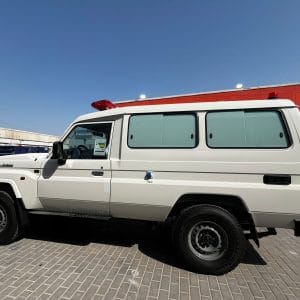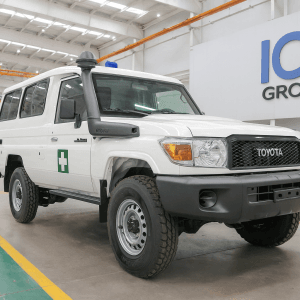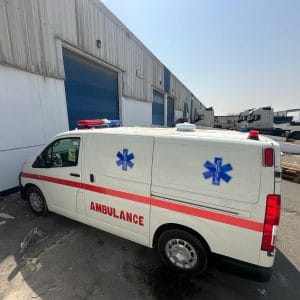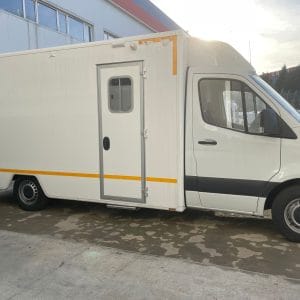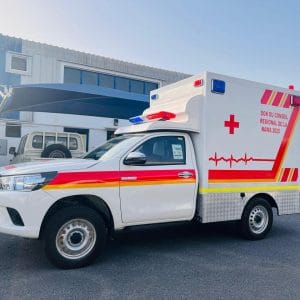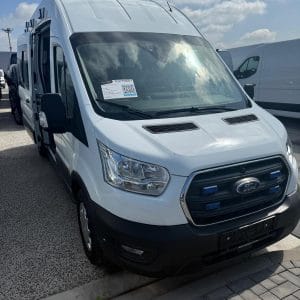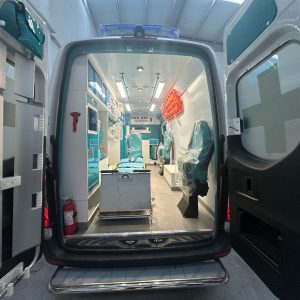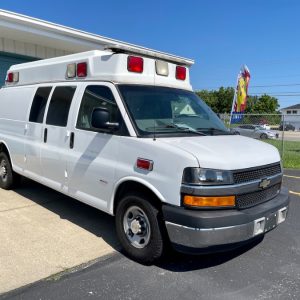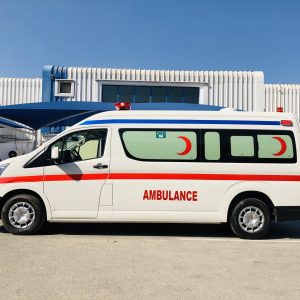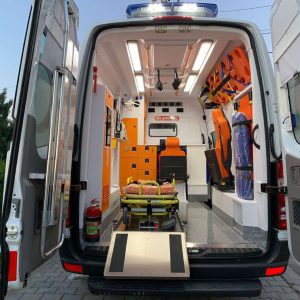Armored Ambulance Price; Armored ambulances are specialty vehicles designed to protect medical personnel in dangerous environments. They provide crucial emergency medical services while safeguarding staff from threats like gunfire, explosives, riots, and other violence.
With global unrest and conflict zones on the rise, armored ambulances have become a vital tool for providing care when normal ambulances would be too vulnerable. They allow aid workers to reach patients in need while minimizing risks. Some key reasons armored ambulances are utilized include:
- Providing emergency services in war zones, areas of civil conflict, high crime locations, or at large events with potential violence. The armoring protects staff from bullets, blasts, and shrapnel.
- Enabling access to dangerous areas that normal ambulances could not safely reach. This allows life-saving care to be delivered to more people in precarious situations.
- Protecting patient privacy and dignity when moving through crowds, checkpoints, or high-risk areas. The armored exterior shields the patient from outside eyes.
- Safeguarding expensive medical equipment from damage, theft, or interference in unstable environments. Sensitive gear is secured inside the armored shell.
- Allowing aid groups to uphold neutrality and avoid becoming targets themselves. The armor provides defensive protection only.
- Deterring attacks, ambushes, or interference by signaling the vehicle is hardened and the occupants prepared.
The need for armored protection is growing globally as humanitarian groups work in ever more complex settings. Armored ambulances provide a practical way to continue delivering urgent medical care despite elevated risks.
What is an Armored Ambulance Price?
An Armored Ambulance Price is an emergency vehicle that has been reinforced and bulletproofed for use in dangerous or hostile environments. Unlike a standard ambulance, an armored ambulance is designed to withstand ballistic attacks, explosions, and other threats.
Key features of an armored ambulance include:
- Bulletproof glass – The windows are made of transparent armor that can stop high-velocity rounds from penetrating into the cabin. This protects medical personnel and patients inside.
- Armored body panels – The exterior walls and roof are reinforced with bulletproof composite materials or steel plating. This protects against gunfire, shrapnel, and blasts.
- Run-flat tires – The tires contain fortified sidewalls that allow the vehicle to be driven even after tire punctures. This enables escaping an ambush situation.
- Upgraded suspension – The suspension is reinforced to handle the extra weight of armoring. It also allows better handling of rough terrain in conflict zones.
- Ram bumpers – Many armored ambulances have a reinforced front bumper which can be used to ram through barricades or clear obstacles.
- Fire suppression – Automatic fire suppression systems rapidly extinguish any onboard fires from explosions or Molotov cocktails.
- Onboard medical oxygen – Extra onboard oxygen capacity for patient care in case oxygen lines are damaged.
- Emergency communications – Radios, satellite links and other redundant communications for coordinating care and security in high-risk areas.
Why Armored Ambulances are Used and Armored Ambulance Price
Armored ambulances provide crucial protection for medical personnel and patients in dangerous areas. They allow emergency responders to safely access and evacuate casualties from conflict zones, areas of civil unrest, and regions with high crime rates.
The key purpose of armoring ambulances is to shield the crew and patients inside from small arms fire. Regular civilian ambulances have little to no ballistic protection, leaving EMTs and patients vulnerable to gunshots, shrapnel, and other threats. Armored variants are designed to withstand multiple bullet impacts from handguns, shotguns, and rifles. The armored shell and bullet-resistant glass provide life-saving protection that allows medical aid to continue during dangerous conditions that would halt standard ambulance services.
In war zones and regions plagued by terrorism, armored ambulances enable medics to evacuate wounded civilians and soldiers while protected against ambushes, IEDs, sniper fire, and other attacks. They also provide security for transporting patients in areas with high rates of violent crime and gang activity. Armoring gives EMTs the confidence to do their job despite significant dangers outside the vehicle. This is crucial for maintaining emergency response capabilities in volatile areas where medical personnel would otherwise be unable to safely operate.
Armored Ambulance Price Key Armoring Materials
Armored ambulances use various materials to provide protection against ballistic threats and explosions. Some commonly used materials include:
- Steel – Steel armor plating provides excellent protection against bullets and fragmentation. It is durable and resistant to impacts. However, steel adds a lot of weight which affects vehicle performance. The thickness required also reduces usable interior space.
- Composite fibers – Materials like aramid, polyethylene, and ultra high-molecular-weight polyethylene fibers are lightweight and offer protection against bullets. Composites can be molded into complex shapes to maximize coverage. But they are less effective against fragmentation and repeated impacts compared to steel.
- Ceramic plates – Ceramic materials like aluminum oxide, boron carbide and silicon carbide are extremely hard. They can shatter bullets and dissipate the impact. Ceramic armor is lighter than steel but the plates are brittle. Their multi-hit capacity is also lower than other materials.
- Glass – Bullet-resistant glass provides transparency while protecting against bullets. It is layered with materials like polycarbonate and acrylic. The glass adds little weight but it is only effective for transparent surfaces. The rest of the vehicle still needs armoring.
The choice of materials involves trade-offs between protection levels, weight, cost, multi-hit capability, and ease of application. Vehicles are often armored with a mix of different materials to optimize for the intended operational environment and threats.
Additional Safety Features
Armored ambulances have a variety of additional safety features to protect paramedics and patients in dangerous situations. Some key features include:
- Bulletproof Glass: The windows are made of thick ballistic glass that can withstand gunfire and explosions. This protects the driver and patient compartment.
- Run-Flat Tires: Special tires allow the ambulance to be driven up to 50 miles if punctured before needing replacement. This helps escape ambush situations.
- Fire Suppression System: Sensors detect excess heat and automatically deploy fire suppressant to prevent the vehicle from catching fire. Crucial if hit by incendiaries.
- Communications Equipment: Armored ambulances have extensive comms to coordinate with police/military during rescues. This includes radios, satellite phones, public address systems, and more. Allows maintaining contact even if regular cell networks are down.
These and other special features optimize armored ambulances to carry out medical rescues even in combat zones or areas of civil unrest. The safety of paramedics and patients is the top priority.
Cost Breakdown
The total cost of an armored ambulance has three main components: the base ambulance cost, the armoring package cost, and any additional features costs.
The base ambulance can range from around $100,000 for a basic Type I ambulance up to $250,000 for a top-of-the-line Type III. This covers the standard ambulance features like the chassis, patient compartment, lighting, sirens, radios, etc.
The armoring package adds substantial cost on top of the base ambulance. Entry-level armoring starts around $60,000. Upgrades like opaque armor, run-flat tires, VR7 glass, and additional layers/panels can bring the armoring cost up to $150,000 or more.
Additional features like power rams, electrified door handles, fire suppression systems, oxygen systems, and specialized medical equipment can tack on another $10,000-$50,000 depending on the capabilities needed.
So in total, an armored ambulance can range from around $200,000 on the low end to over $400,000 for a fully equipped tactical model. The armoring package is usually the biggest variable accounting for 30-50% of the total cost.
Armored Ambulance Price Total Costs
The total cost of an armored ambulance can vary greatly depending on the level of armoring, size of the vehicle, additional features included, and other customizations. However, on average, an armored ambulance will cost between $80,000 to $500,000.
The most significant factor impacting the total cost is the level and extent of armoring. Entry-level armor that provides basic ballistic protection against handguns and fragmentation starts around $250,000. Upgrading to withstand rifle fire can add $50,000 to $100,000. And maximum-level armoring to withstand explosives and heavy weaponry can cost over $100,000 more.
Beyond armoring, larger ambulance sizes, more medical equipment, and additional defensive features will also increase costs. Larger ambulances have more surface area to armor. More built-in medical devices and technologies add to the base price. And extras like run-flat tires, sirens, and defensive spray systems also raise the total price. Location and shipping fees are another consideration for the total budget.
In summary, while a basic armored ambulance starts around a quarter million dollars, most upgraded vehicles with maximum protection and features will end up costing between $400,000 to $500,000 or more. The intended use, required level of protection, size, and custom features all impact the final price. Careful planning and prioritization are key to get an effective armored ambulance within budget constraints.
Major Suppliers
Some of the top companies that outfit and sell armored ambulances include:
- Infinity Chassis Units Armored Ambulance– Based in Turkey, ICU has been armoring vehicles since the 2020s. They build custom armored ambulances for clients worldwide, offering different levels of armor and features. Their ambulances provide protection against ballistic threats and are designed for use in conflict zones or areas with high risk.
- Labock Technologies – Located in the United Arab Emirates, Labock Technologies specializes in armoring land vehicles. They provide armored ambulances to clients in the Middle East and Africa. Their ambulances offer protection against small arms fire and explosive devices.
- Alpine Armoring – Based in the United States, Alpine Armoring has armored over 30,000 vehicles. They provide armored ambulances for emergency services and military clients. Their ambulances are designed to withstand ballistic, blast, and fragmentation threats. Alpine has extensive experience armoring ambulances and emergency response vehicles.
- Jankel Armouring – A UK company, Jankel Armouring outfits different vehicles with armor including ambulances. They provide lightweight and discreet armored ambulances ideal for protection against small arms ambushes, IEDs, and other attacks. Jankel exports their armored ambulances worldwide.
- Plasan – Headquartered in Israel, Plasan specializes in vehicle armor systems. They provide armored ambulances and have extensive experience protecting emergency response vehicles operating in dangerous areas. Plasan armor is designed to be lightweight to maintain vehicle performance.
Acquisition Process
Emergency services looking to acquire armored ambulances have a few options for purchasing them. Much of the process depends on available funding sources.
Most emergency services will go through a standard procurement process, putting out requests for proposals from armored vehicle suppliers. They will evaluate bids based on pricing, vehicle specifications, delivery timelines, and other factors. The contracting process can take 3-6 months in many cases.
For funding, emergency services have a few potential sources:
- Operating budgets – Some services can fund armored ambulances through their annual operating budgets, especially in major metro areas. However, the high price tag often requires additional funding sources.
- Government grants – There are state and federal grant programs available to help emergency services acquire armored vehicles. These include programs under the Department of Homeland Security and initiatives like the Urban Area Security Initiative. Grants often require cost sharing from the local agency.
- Asset forfeiture funds – Some emergency services acquire armored vehicles using funds from asset forfeitures, often from drug enforcement activities. However, use of these funds faces public criticism in some regions.
- Community fundraising – For smaller emergency services, fundraising from local community organizations, businesses, or individuals can help cover the costs of armored ambulances.
The acquisition process involves navigating the procurement procedures while securing full funding. With an average cost of $250,000-$500,000, armored ambulances remain a major investment for most emergency responders. Proper planning and preparation can lead to successful acquisition and deployment.
The Future of Armored Ambulances and Armored Ambulance Price
Armored ambulances are likely to become more widely adopted in the coming years as the technology continues to advance and become more affordable. Here are some key innovations and predictions for the future of armored ambulances:
New Technology and Innovations
- Lighter, stronger materials – New composite materials like dyneema and ultra high molecular weight polyethylene are being used more in armor, allowing for lighter and thinner armor panels without sacrificing ballistic protection. This helps reduce weight and improve fuel efficiency.
- Active protection systems – Some armored ambulances are incorporating active protection systems like automated radar warning receivers, laser warning systems, and even hard-kill anti-projectile interceptors. These can detect threats and deploy countermeasures.
- Run-flat tires – Run-flat tire technology is being implemented to allow ambulances to drive on punctured tires so they can escape the line of fire.
- Battery backups – Integrated battery systems act as a backup power source to keep critical systems running if the engine fails due to damage.
- Driver assist systems – Armored ambulances are implementing more driver assist and autonomous driving capabilities to aid in evasive and defensive driving.
Armored Ambulance Price Increased Adoption Predictions
- More demand from EMTs – With rising violent attacks on EMTs and paramedics, there is increasing demand for armored protection from ambulance crews themselves. Unions and organizations may lobby for armored ambulances.
- Use in active shooter incidents – Armored ambulances allow EMTs to safely enter hot zones to extract victims during active shooter events. Their adoption for this purpose is increasing.
- Expanded urban use – Armored ambulances are moving beyond conflict zones to major cities to protect against riots, gang violence, and terrorist threats.
- International demand growing – More countries around the world are utilizing armored ambulances for enhanced protection of EMTs and patients. Their use is spreading globally.
The future points to expanded use of armored ambulances with new innovations that improve protective capabilities while reducing weight, improving mobility and efficiency. As threats evolve, armored ambulances are becoming a necessity.



